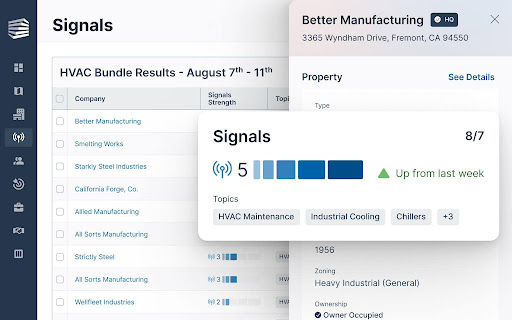Introduction
For commercial services companies—like those in HVAC, electrical, roofing, and janitorial work—staying efficient is critical to profitability.
In these industries, sales teams can face long sales cycles, aggressive gatekeepers, multiple decision-makers, and complicated property landscapes.
Success requires more than traditional sales tactics; it demands tools that streamline the sales process to help you find and close high-value deals.
This is where property intelligence data is a game-changer. It’s a powerful tool that helps teams find, qualify, and connect directly with prospects based on their unique needs.
In this article, we’ll explore how property intelligence data can transform your sales process. We will discuss how these tools enhance sales efficiency, streamline the sales cycle, and share effective strategies to elevate your team’s performance.
Understanding Sales Efficiency

If you’re unfamiliar with the term and ask, “What is sales efficiency?” Sales efficiency measures how well a sales team turns time and resources into revenue.
Put simply, it’s the ratio of money made to the costs of sales and marketing efforts.
A high sales efficiency ratio (4:1) means that the team is doing a great job converting their input (like time and money) into actual revenue. Lower efficiency numbers (.75:1) mean that it’s taking a lot more time and resources to generate the same amount of sales.
Improving sales efficiency is a core driver of profitable growth for commercial services businesses, where profit margins can be thin.
Sales Efficiency Metric and Magic Number
Metrics like the Sales Efficiency Ratio and the Sales Efficiency Magic Number show how productive your sales process is.
These are calculated by dividing the revenue by sales and marketing costs. For example, if your company earns $3 million in a year and spends $1.5 million on sales and marketing, your sales efficiency ratio is 2:1. This ratio means you’re generating $2 for every $1 spent.
But how can you improve this efficiency? Put simply: increase sales performance and lower sales operations costs.
The True Cost of Traditional Prospecting and Lead Generation

Traditional lead generation methods can be time-consuming, fragmented, and costly, especially in commercial services. Here’s a look at some common tactics and their downsides:
Canvassing and Driving for Dollars: Sales teams often drive through neighborhoods or business areas, identifying potential properties by sight alone. This “guess and check” approach not only costs time but also racks up transportation expenses and is far from efficient.
LinkedIn Hunts and Online Contact Searches: Trying to track down property owners or decision-makers through LinkedIn and other online platforms is labor-intensive and often yields incomplete information. Hours can be wasted sending connection requests or cold messages with no guarantee of reaching the right person.
Checking Libraries for Permit History: For sales teams seeking commercial opportunities, permit history can be a goldmine of information. But if you’re manually searching through public records or visiting libraries to check permits, you’re losing valuable time that could be spent engaging prospects.
Using Fragmented Tools: Many teams rely on separate tools for CRM, territory planning, data collection, and outreach. The time spent toggling between these systems leads to lost productivity and can result in missed opportunities when data isn’t synced across platforms.
These methods not only take time and money but often result in lost opportunities as prospects slip through the cracks. Convex’s property intelligence platform transforms this process by consolidating all necessary information and simplifying prospecting.
A Simple Four-Step Process to Finding Deals with Convex

Old-school sales methods, like driving around to find leads, digging through LinkedIn for contact details, or hunting down permit history at local libraries, are slow, costly, and often don’t get the best results. Convex changes all that, making it faster and easier to find high-quality leads. Let’s look at how Convex’s four-step process, combined with three smart strategies, can help your sales team work more efficiently.
Prospecting and Lead Generation Using a Simple Four-step Process
Log in and Check Buying Signals: Start by opening Convex and checking the “Signals” section. This data shows you which prospects might be interested in your services now, helping you focus on those most likely to convert.
Search by Property Type and Get Key Decision-Maker Info: Whether you’re looking for HVAC, roofing, or other commercial service leads, Convex lets you filter by property type. You’ll instantly see key details like contact info, building size, property type, and maintenance history—all in one place.
Use Generative AI for Outreach: Convex’s Generative AI tools help you create custom emails or call scripts based on the prospect’s needs. Pro tip: You can even use these scripts to make personalized Loom videos to allow lead to put a face with a name so you’re not just another generic cold email.
Automate Reminders, Follow-Ups, and Connect with Your CRM: After reaching out, set up automated follow-ups or reminders. You can use Convex’s built-in sales pipeline tools or sync these contacts with your CRM (like Salesforce or HubSpot) to stay organized and track progress easily.
This process removes the headaches of traditional prospecting. Instead, you save time and energy by focusing on leads that matter. Now, let’s look at three ways Convex’s data tools can improve your sales even more.
3 Key Ways to Improve Sales Efficiency with Property Data

1. Find High-Value Prospects Faster
Traditional methods usually involve casting a wide net and hoping for the best. However, property intelligence lets you focus on high-value leads by filtering based on factors like building age, size, and type.
This means you spend less time chasing low-potential leads and more time with prospects who need your services.
2. Personalize Your Approach with Buying Signals
One of the toughest parts of sales is breaking through to decision-makers.
With Signals and buyer intent data, you can get insights into each property’s specific needs and what decision-makers for those accounts are actively trying to find. This lets your team send customized messages that speak directly to the prospect’s situation, making it easier to get meetings and close deals.
3. Optimize Territory Management
Property intelligence that’s built into a map interface provides a full view of your target market, helping your team map out territories and see qualified leads.
This setup reduces travel time and helps reps spend more time in the field closing deals, not just “driving for dollars.”
With these three keys, you can increase sales performance by reducing the time spent on research activities. The added effect is increased velocity. Finding a lead in 3- 5 minutes rather than hours or days and having all the data in one place is a huge advantage to accelerating sales.
Strategies to Improve Sales Performance with Property Intelligence

Property intelligence data does more than just help your sales team with prospecting. Here are three ways it can improve the team’s overall sales performance:
1. The Quickest Way to Increase Sales: By using property data, teams can spot prospects actively looking for your services. This regularly updated data might show, for instance, a recent permit for HVAC or electrical upgrades, or it could show you that a property owner or manager is actively looking for commercial cleaning and janitorial services. Acting on these leads can result in faster deal flow and shorter sales cycles because you’re contacting people who need your services.
2. Personalized Outreach Based on Data: Insights from property data allow for tailored outreach. Sales reps can create messages that speak directly to the needs of a prospect’s property, cutting through the noise and making it more likely to get meetings and close deals.
3. Streamlining the Sales Process: An efficient sales process means less time spent on admin tasks and more time selling. Integrating property data with CRM systems can automate tasks like lead scoring, follow-ups, and territory planning, freeing up sales teams to focus on valuable interactions.
Sales efficiency is a lot like being a cancer surgeon. You’re removing what doesn’t belong to create a healthier environment overall!
Customer Case Study: How Comfort Systems Doubled Growth with Efficient Sales Tools

In 2017, Comfort Systems USA Southwest faced a challenge: how to capture more business efficiently across Arizona and New Mexico.
Traditional prospecting methods, like searching LinkedIn or driving around to find leads, often took hours and yielded mixed results.
With $100 billion in potential install base to pursue, Southwest Division President Craig Little recognized they needed a better way to focus on high-value prospects.
Streamlined Prospecting with Property Intelligence
Atlas allowed Comfort Systems to quickly target properties based on factors like building size and ownership status. This targeted approach helped their sales consultants spend just a few hours a week identifying leads and engaging decision-makers with personalized, data-backed insights.
“Now, I know exactly who to go after,” shared Joel Martos, a Sales Consultant at Comfort Systems USA Southwest.
Doubling Sales
Since adopting Convex, Comfort Systems has more than doubled in sales, with Atlas at the core of its prospecting. By helping them pinpoint qualified leads and save time, Atlas became an essential part of their strategy. As Sales Director Brian Ruffner noted, “Atlas has become the centerpiece of all of our prospecting efforts.”
This real-world example shows how sales efficiency tools like Convex allow companies to scale faster and reach high-potential clients with ease.
Key Sales Efficiency Metrics to Track

Tracking the right metrics is the first step to measuring your company’s sales efficiency. First, you have to calculate your sales efficiency ratio.
Sales Efficiency Ratio: This shows how much revenue is generated for each dollar spent on sales and marketing. The higher the ratio, the better the efficiency.
Conversion Rate: Next, track how many leads turn into customers. A high conversion rate usually means a more efficient sales process.
Sales Cycle Length: Finally, take into account your average sales cycle length. This quicker you close deals on average (there will be outliers), the better your efficiency.
Now, take a look at what you can remove from the sales process. For instance, are there any redundant tasks taking up time like manual data entry or outdated prospecting methods?
By identifying and eliminating these inefficiencies, your sales team can focus on high-value activities that lead to increased revenue.
Conclusion: Empowering Sales Teams with Property Intelligence

In today’s competitive world, efficiency isn’t optional—it’s the key to profitable growth.
Property intelligence data gives commercial services companies a tool to increase sales efficiency, helping sales reps identify high-value prospects, qualify leads with confidence, and manage their resources effectively.
Whether you’re in HVAC, janitorial services, roofing, or another commercial service, using property intelligence data can transform your sales process. If you’re ready to see how property intelligence can transform your sales, schedule a free demo of Convex today.
Share





